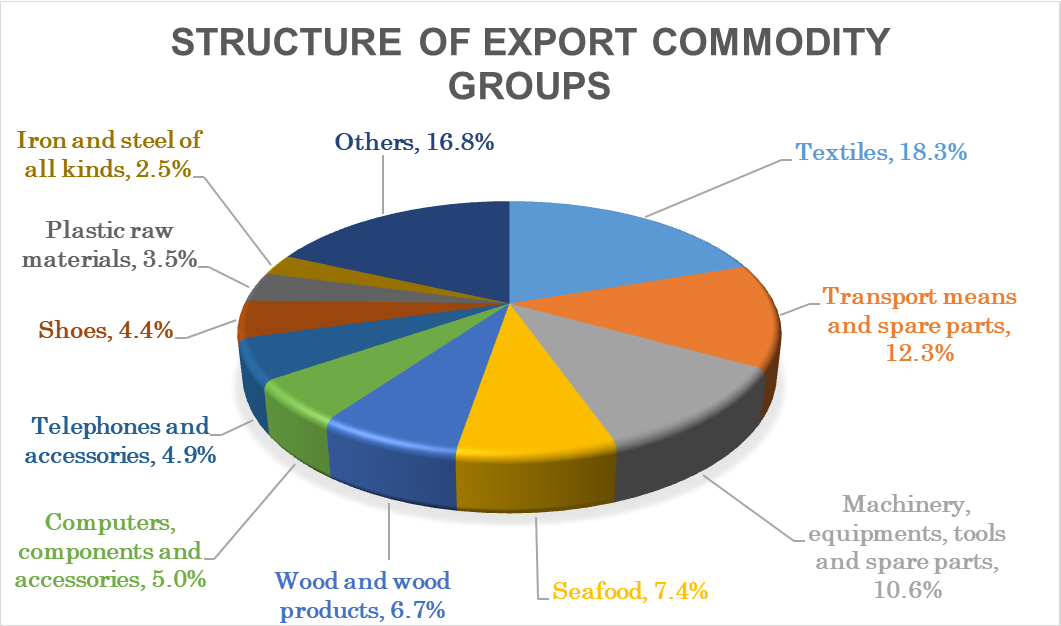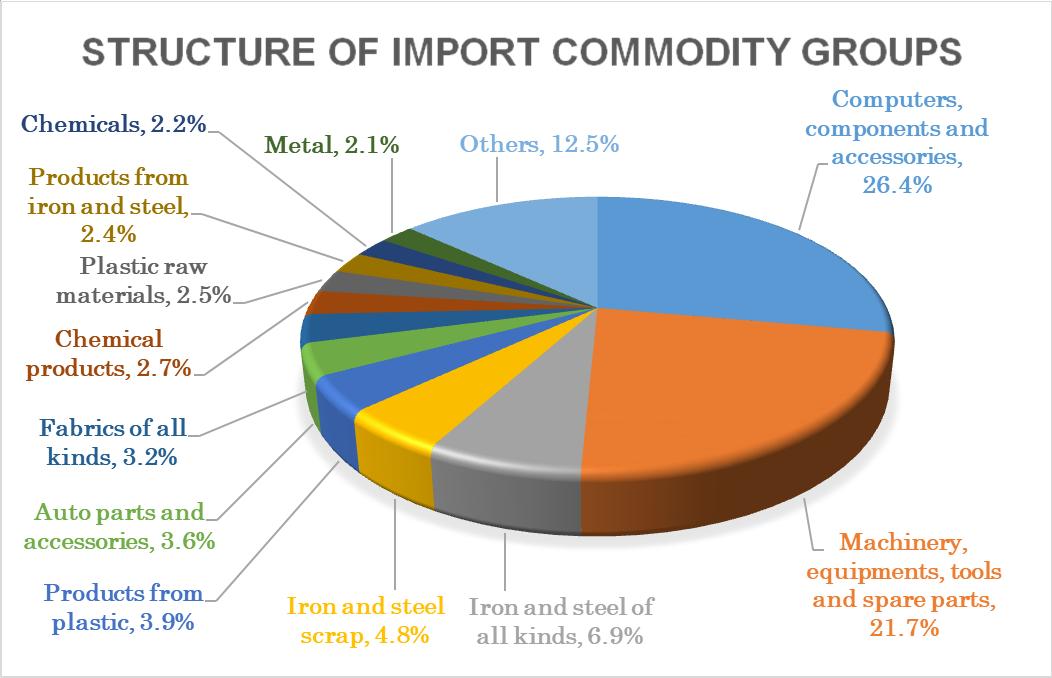OVERVIEW OF VIET NAM - JAPAN
TRADE COOPERATION
Viet Nam and Japan now enjoy the strongest and most fruitful cooperation since the establishment of diplomatic relations in 1973. The two countries established the Strategic Partnership in 2009 and upgraded to the Extensive Strategic Partnership for Peace and Prosperity in Asia in March 2014. The Viet Nam-Japan Extensive Strategic Partnership is growing robustly, comprehensively and substantively in various areas. This is showcased not only through the exchange of high-level official visits between the two Governments but also in the bilateral trade turnover in recent years.
So far, Japan has always been one of Viet Nam's leading trade partners. In 2020, Japan was the 4th largest trade partner with the total trade volume of nearly 40 billion USD, and the 3rd largest export and import market of Viet Nam.
A number of legal frameworks and on-going cooperation mechanisms in trade and industry between Viet Nam and Japan
Legal frameworks:
- The ASEAN-Japan Comprehensive Economic Partnership Agreement (AJCEP), in effect since December 1st, 2008.
- The Viet Nam - Japan Economic Partnership Agreement (VJEPA), in effect since October 1st, 2009.
- The Comprehensive and Progressive Agreement for Trans-Pacific Partnership (CPTPP), in effect since December 30, 2018.
- The Regional Comprehensive Economic Partnership (RCEP), signed by 15 RCEP countries (except India) on November 15, 2020.
Cooperation mechanisms:
- Viet Nam - Japan Joint Committee on Cooperation in Trade, Industry and Energy: established by the two countries and co-chaired by the Minister of Industry and Trade of Viet Nam and the Minister of Economy, Trade and Industry of Japan (METI). This Joint Committee is convened annually on a rotating basis (the 5th meeting is scheduled for 2021 in Japan).

(The 4th Meeting of the Vietnam - Japan Joint Committee on Industry, Trade and Energy Cooperation (JC) was held in Vietnam in the afternoon of August 7th, 2020 in virtual format)
In Kansai:
- Memorandums of Understanding on Cooperation between Vietnamese provinces and cities and Japanese localities in Kansai (e.g. Ho Chi Minh City and Hyogo Prefecture; Da Nang City and Osaka Prefecture; Dong Nai Province and Kansai Bureau of Economy, Trade and Industry; Da Nang City and Sakai City; Quang Nam Province and Kinokawa City....).
- Memorandum of Understanding on Cooperation in Trade, Industry and Energy signed by the Ministry of Industry and Trade of Viet Nam with the Kansai Bureau of Economy, Trade and Industry (continuously maintained since its first signing in November 2012) and with Wakayama Prefecture (signed in October 2018).
Current bilateral trade cooperation
Since 2008, thanks to bilateral and multilateral free trade agreements to which both countries are parties, including AJCEP, VJEPA, and CPTPP, the trade relations between Viet Nam and Japan have enjoyed more favorable conditions for growth, thus enabling Japan to become the leading trade partner of Viet Nam. At the same time, according to Japanese statistics, in 2017, Viet Nam surpassed Indonesia and ranked 9th out of 10 countries worldwide with the largest total import and export turnovers with Japan (about 3,767.2 billion Yen, accounting for 2.5% of total imports and exports). In 2019, Viet Nam ranked 8th, with the total import and export turnover reaching 2.7%.
In 2020, Viet Nam's total trade volume with Japan amounted to 39.6 billion USD, accounting for 7.2% of Viet Nam's total trade volume with other countries. As for exports, Japan is currently the 3rd largest export market of Viet Nam, with a turnover of nearly 19.3 billion USD. As for imports, Japan is also the 3rd largest import market of Viet Nam, with a turnover of 20.3 billion USD. Viet Nam's trade deficit with Japan is about $1 billion, lower than that of 2019 by 233.3%.

In the first 4 months of 2021, Viet Nam's import and export turnover with Japan reached 13.7 billion USD, an increase of 5.9% against same period of 2020. As for export, Viet Nam's export turnover to Japan reached 6.6 billion USD, increased by 2.7% against 2020. As for import, Viet Nam's import turnover from Japan reached 7.1 billion USD, a year-on-year increase of 9.2%. The trade deficit with Japan is about 470.7 million USD, a year-on-year increase of 891.4%.
It is important to note the complementarity and low direct competition in the trade between the two countries. Viet Nam mainly produces and exports to Japan seafood, crude oil, textiles, electrical wires and cables, timber and wood products, computers and components, coal, and footwear, while imports from Japan are mainly goods used for Viet Nam's production and export activities, including machinery, equipments, tools and spare parts, electronic products, components, and accessories, iron and steel of all kinds, fabrics of all kinds, auto parts, plastic raw materials, chemicals, and raw materials for textile, garment, leather, shoes, and metal.

Import and export turnover between the Kansai region and Viet Nam
According to Japanese Customs statistics, the total import-export turnover between the Kansai region and Viet Nam in 2020 was 9.39 billion USD. Exports from Viet Nam to Kansai reached 4.67 billion USD, a year-on-year increase of 0.61%, while Viet Nam's imports from Kansai reached 4.72 billion USD, a year-on-year decrease of 4.77%.
In just April 2021, the total trade volume between the Kansai region and Viet Nam was 975.5 million USD, a year-on-year increase of 23.91%. Exports reached 531.9 million USD, a year-on-year increase of 43.5%, and accounted for 3.6% of the total export value of the Kansai region. Imports reached 443.6 million USD, a year-on-year increase of 6.3%, and accounted for 3.8% of the total import value of the Kansai region. In the first 4 months of 2021, the import and export turnover between the Kansai region and Viet Nam amounted to 3.47 billion USD, increasing by 8.03%; in which exports reached 1.79 billion USD and imports reached 1.68 billion USD, a year-on-year increase of 8.69%, and 7.34% respectively./.
(June 2021)



